Shah Shuja (Mughal prince)
| Shah Shuja شاہ شُجاع | |
|---|---|
| Mughal Prince | |
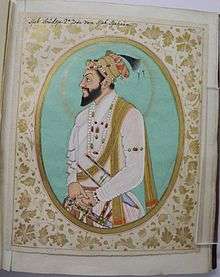 Portrait of Shah Shuja | |
| Born |
23 June 1616 Ajmer |
| Died | 7 February 1661 (aged 44) |
| Spouse |
Bilqis Banu Begum Piari Banu Begum One another wife |
| Issue |
Zain-ud-Din Mirza Zain-ul-Abidin Mirza Buland Akhtar Mirza Dilpazir Banu Begum Gulrukh Banu Begum Roshan Ara Begum Amina Banu Begum |
| House | Timurid |
| Father | Shah Jahan |
| Mother | Mumtaz Mahal |
| Religion | Islam |
Shah Shuja (Urdu: شاہ شُجاع ), (23 June 1616 – 7 February 1661)[1] was the second son of the Mughal Emperor Shah Jahan and Empress Mumtaz Mahal. He was the governor of Bengal and Odissa and had his capital at Dhaka, presently Bangladesh.
Early life and family
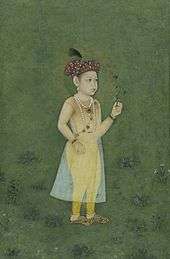
Shah Shuja was born on 23 June 1616, in Ajmer. He was the second son and child of Mughal emperor Shah Jahan and his queen Mumtaz Mahal.
Shuja's siblings were Jahanara Begum, Dara Shikoh, Roshanara Begum, Aurangzeb, Murad Baksh, Gauhara Begum and others. He had three sons - Sultan Zain-ul-Din (Bon Sultan or Sultan Bang), Buland Akhtar and Zainul Abidin and four daughters - Gulrukh Banu, Roshanara Begum and Amina Begum.[2]
Personal life
Shah Shuja married firstly Bilqis Banu Begum, the daughter of Rustam Mirza, on the night of Saturday, 5 March 1633. The marriage was arranged by Princess Jahanara Begum. Rupees 1,60,000 in cash and one lakh worth lakh of goods were sent as sachak to the mansion of Mirza Rustam. On 23 February 1633, the wedding presents worth Rupees 10 lakhs were displayed by Jahanara Begum and Sati-un-nissa Khanum.[3] The following year she gave birth to a daughter, and died in childbirth. She was buried in a separate mausoleum named Kharbuza Mahal, at Burhanpur.[4] Her daughter was named Dipazir Banu Begum by Shah Jahan,[5] and who died as an infant.
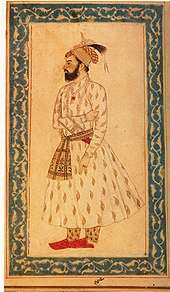
On the death of his first wife, he married Piari Banu Begum,[6] daughter of Azam Khan, second governor of Bengal during Shah Jahan's reign.[7][8] She was the mother of two sons, and three daughters,[9] namely, Prince Zain-ud-din Mirza born on 28 October 1639, Prince Zain-ul-Abidin Mirza born on 20 December 1645, Gulrukh Banu Begum (wife of Prince Muhammad Sultan), Raushan Ara Begum, and Amina Banu Begum.[10] In 1660, she fled to Arakan with her husband, sons, and three daughters. Shuja was murdered in 1661. His sons were put to death. Piari Banu Begum, and her two daughters committed suicide. The remaining daughter, Amina Banu Begum, was brought into the palace, where from grief she died an early death.[11][12] According to another source, one of Shuja's daughters was married to King Sanda Thudhamma. A year later he scented a plot and starved all of them to death, while his wife was in an advanced stage of pregnancy by himself.[13]
His third wife was the daughter of Raja Tamsen of Kishtwar.[14] She was the mother of Shahzada Buland Akhtar who was born in August 1645.[15]
He died in 7 February 1661 at the age of 44.
Governor of Bengal
Shazada Muhammad Shah Shuja was appointed by Shah Jahan as the Subahdar of Bengal and Bihar from 1641 and of Orissa from 25 July 1648 until 1661. His father Shah Jahan appointed his deputy The Rajput Prince of Nagpur Kunwar Raghav Singh(1616-1671).[1][16] During his governorship, he built the official residence Bara Katra in the capital Dhaka.[17]
After the illness of Shah Jahan in September 1657, a power crisis occurred among the brothers. Shah Shuja proclaimed himself as Emperor, but Aurangzeb ascended the throne of Dheli and sent Mir Jumla to subjugate Shuja.[18] Shuja was defeated in the Battle of Khajwa on 5 January 1659.[1] He retreated first to Tandah and then to Dhaka on 12 April 1660.[1] He left Dhaka on 6 May and boarded ships near present-day Bhulua on 12 May heading Arakan.[1] Mir Jumla reached Dhaka on 9 May 1660 and was then appointed by Aurangzeb as the next Subahdar of Bengal.[18]
Construction projects in Dhaka
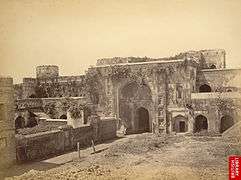 Bara Katra
Bara Katra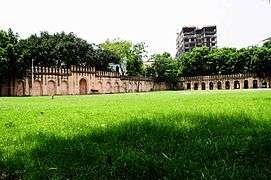
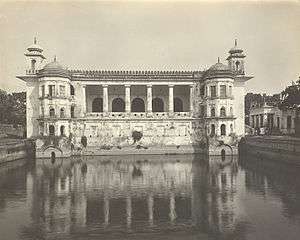
.jpg) An etching of Bara Katra by Sir Charles D'Oyly in 1823
An etching of Bara Katra by Sir Charles D'Oyly in 1823
Mughal war of succession
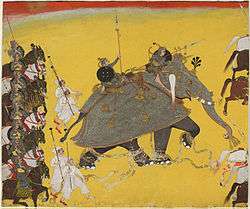
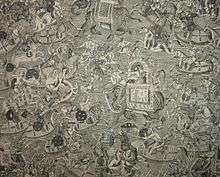
When Shah Jahan fell ill, a struggle for the throne started between his four sons - Dara Shikoh, Shah Shuja, Aurangzeb and Murad Baksh. Shuja immediately crowned himself the emperor and took imperial titles, November 1657.
He marched with a large army, backed by a good number of war-boats in the river Ganges. However, he was beaten by Dara's army in a hotly contested Battle of Bahadurpur near Banares (in modern Uttar Pradesh, India). Shuja turned back to Rajmahal to make further preparations. He signed a treaty with his elder brother Dara, which left him in control of Bengal, Orissa and a large part of Bihar, 17 May 1658.
In the meantime, Aurangzeb defeated Dara twice (at Dharmat and Samugarh), caught him, executed him on a charge of heresy and ascended the throne. Shuja marched again to the capital, this time against Aurangzeb. A battle took place on 5 January 1659 at the Battle of Khajwa (Fatehpur district, Uttar Pradesh, India) where Shuja was defeated.[19]
After his defeat, Shuja retreated towards Bengal. He was pursued by the imperial army under Mir Jumla. Shuja put up a good fight against them. However, he was finally defeated in the last battle in April 1660. After each defeat he had to face desertions in his own army, but he did not lose heart. He, rather, reorganised the army with renewed vigor. But when he was going to be surrounded at Tandah, and when he found that reorganisation of the army was no longer possible, he decided to leave Bengal for good and take shelter in Arakan.
Military promotions
- 1636 - 5000(20)
- 1641 - 30,000(25)
- 1646 - 36,000(30)
- 1653 - 40,000(37)
- 1655 - 43,000(39)
Asylum in Arakan
En route to Arakan
Shuja left Tandah with his family and retinue in the afternoon of 6 April 1660 and reached Dhaka on 12 April. He left Dhaka on 6 May and boarded the Arakanese ships on 12 May at Bhulua (near present-day Noakhali, Bangladesh).
Shuja first arrived at Chittagong and stayed for some time, from where he took the land route to Arakan which is still called Shuja Road. Thousand palanquins (carriers) carried the harem ladies and Shuja prayed Eid prayer at a place Edgoung (Eidgah) in Dulahzara which is still in Chittagong on the way to Arakan.
Shuja undertook the land journey for 13 days and 13 nights with a troubled mind on the eastern bank of Naf River, half a mile north of Maungdaw town which is still known as Shuja village. Some of Shuja’s retinues there were later retained by the British army as archers army since 1826.
Betrayal in Arakan
Shuja and his entourage arrived at Arakan on August 26, 1660,[20] where they were received by an envoy of Arakan king Sanda Thudhamma and escorted to quarters set aside. Shuja apparently went to Arakan as Sanda Thudhamma promised to provide him ships to take Shuja to Mecca for haj (pilgrimage).
Meanwhile the Mughal emperor had also deposed the ruler of (Hindu) Tripura, Govinda Manikya and enthroned Chhatra Manikya (reigned 1661–66). Govinda who also fled to Arakan, where he met Shuja.[21]
Thudhamma broke his promise to Shuja, and confiscated gold and jewelry belonging to him. In December 1660, Zain-ul-Din Muhammad and another brother reportedly led a Mughal attack on Thudamma, and nearly succeeded in setting fire to the royal palace; many Mughals were massacred.[22] Others, who escaped from the capital, were recaptured, on 7 February 1661, in jungle near Mrohaung. One account, apparently false, claimed that Shuja was killed at this time.[16] Another account had it that Suddama's mother prevented the killing of Shuja, on the grounds that he was a guest of kingly status. Some accounts state that Zain-ul-Din Muhammad and another brother had already died in fighting at the palace, while others state that all three sons were captured near Mrohaung in 1661 and later (circa 25 July 1663) beheaded there with a blunt axe, following an abortive rescue attempt by the Subadar of Bengal).[16] Prince Shah Shuja's daughter Princess Gulrukh Banu Begum was raped by Sanda Thudhamma and committed suicide circa 25 July 1663, Another daughters Princess Pazir Begum(23), Princess Amina Banu Begum was only 2 years old girl was sent with her sister Pazir and Prince Azim Shuja (1657-1700) who was the Shuja grandson to Emperor Aurangzeb. [23] The surviving members of Shaju's party, helped reportedly by Mughals and Pathans resident at Arakan,[24] travelled north with Portuguese mariners, who demanded a heavy price in gold and jewels.
The kings of Tripura and Manipur were more agreeable hosts – probably because they did not like the expansionist policy of Aurangzeb – and played a crucial role in concealing Shuja's whereabouts. He and his party arrived at Tripura on 16 May 1661,[24] and in Manipur in December 1661.[25] The surviving Mughals with Shuja arrived in Tripura on 16 May 1661 with much difficulty[20] and arrived in Manipur in December 1661.[26] Conscious that Aurangzeb’s scouts and spies were searching for them,[27] misinformation was spread that Shuja had died at Arakan, or was travelling to Mecca, among other stories.[24] Among other precautionary measures, Shuja was sent by elephant to the hill country of Ukhrul .[28] In 1662, the king of Manipur, Khunjaoba, sent a three man embassy to the court of Aurangzeb.[29] At around the same time, the Qazi of Manipur, Muhammad Sani, detained the Mughal ambassador Nur Beg, so that Mughal messengers Dur Beg and Rustam Beg did not report Shuja’s presence in Manipur.[30]
Mir Jumla came to know of the situation and the Mughals sent a three men embassy to Manipur in late December 1661, to retrieve Shuja's family.[31] At that time, however, Shuja was in hiding at a cave now known as Shuja-lok ("Shuja Cave"),[32] Haignang, Kairang (east of Imphal),
Govinda Manikya subsequently reclaimed the throne of Tripura, dethroning Chhatra Manikya, and ruled Tripura from 1667 to 1675.[33]
Fleeing to Manipur

On the breach of trust by Arakan king Sanda Thudhamma, Shuja fled back to Tripura whose king quickly dispatched Shuja to Manipur in 1661 so that it might not antagonize the military force of Aurangzeb led by Mir Jumla II.
The Mughals lately came to know of the situation but Shuja was already gone. Shah Shuja reached Manipur in December 1661 according to Cheitharol Kumbaba.[34] The Mughals sent a three men embassy to Manipur in late December 1661, this time to retrieve the aggrieved family of Shuja.[29] At that time Shuja was taking shelter in at Haignang of Kairang (east of Imphal), now known as Shuja-lok (Shuja cave).[32]
Mughals enthroned Chhatra Manikya (ruling 1661-66) in Tripura while Govinda Manikya too fled to Arakan where he again met Shuja.[35] In the meantime in Tripura, Chhatra Manikya was too dethroned and Govinda Manikya came back from Arakan to claim the throne and ruled Tripura again from 1667 to 1675.[33]
The Manipur king Khunjaoba sent back a three-man embassy to the court of the Mughal emperor Aurangzeb in 1662.[31] A Mughal ambassador, Nur Beg, was held back in Manipur by the Qazi of Manipur, Muhammad Sani. It was done so that the retreating two Mughal commanders named Dur Beg and Rustam Beg should tell about Shuja’s existence in Manipur.[30] Yet, Shuja was sent up to Ukhrul hill with some Muslims (already settled in Manipur) as precautionary measure from Mughal informers. Thus Tripura and Manipur kings played crucial roles in saving the life of Shah Shuja and his family.
Ancestry
| Ancestors of Shah Shuja (Mughal prince) | |||||||||||||||||||||||||||||||||||||||||||||||||||||||||||||||||||||||||||||||||||||||||||||||||||||||||||||||||||||||||||||||||||||||||||||||||||||||||||||||||||||||||||||||||||||||||||||||||||||||||||||||||||||||||||||||||||||||||||||||||||||||||||||||||||||||||
|---|---|---|---|---|---|---|---|---|---|---|---|---|---|---|---|---|---|---|---|---|---|---|---|---|---|---|---|---|---|---|---|---|---|---|---|---|---|---|---|---|---|---|---|---|---|---|---|---|---|---|---|---|---|---|---|---|---|---|---|---|---|---|---|---|---|---|---|---|---|---|---|---|---|---|---|---|---|---|---|---|---|---|---|---|---|---|---|---|---|---|---|---|---|---|---|---|---|---|---|---|---|---|---|---|---|---|---|---|---|---|---|---|---|---|---|---|---|---|---|---|---|---|---|---|---|---|---|---|---|---|---|---|---|---|---|---|---|---|---|---|---|---|---|---|---|---|---|---|---|---|---|---|---|---|---|---|---|---|---|---|---|---|---|---|---|---|---|---|---|---|---|---|---|---|---|---|---|---|---|---|---|---|---|---|---|---|---|---|---|---|---|---|---|---|---|---|---|---|---|---|---|---|---|---|---|---|---|---|---|---|---|---|---|---|---|---|---|---|---|---|---|---|---|---|---|---|---|---|---|---|---|---|---|---|---|---|---|---|---|---|---|---|---|---|---|---|---|---|---|---|---|---|---|---|---|---|---|---|---|---|---|---|---|---|---|
| |||||||||||||||||||||||||||||||||||||||||||||||||||||||||||||||||||||||||||||||||||||||||||||||||||||||||||||||||||||||||||||||||||||||||||||||||||||||||||||||||||||||||||||||||||||||||||||||||||||||||||||||||||||||||||||||||||||||||||||||||||||||||||||||||||||||||
See also
| Wikimedia Commons has media related to Shah Shuja. |
References
- 1 2 3 4 5 Abdul Karim. "Shah Shuja". Banglapedia. Retrieved 2013-01-24.
- ↑ Stanley Lane-Pool, 1971, Aurangzeb, vol.1.
- ↑ Mukherjee, Soma (2001). Royal Mughal Ladies and Their Contributions. Gyan Books. p. 106. ISBN 978-8-121-20760-7.
- ↑ Haidar, Navina Najat; Sardar, Marika (April 13, 2015). Sultans of Deccan India, 1500–1700: Opulence and Fantasy. Metropolitan Museum of Art. p. 285. ISBN 978-0-300-21110-8.
- ↑ Jain, Simi (2003). Encyclopaedia of Indian Women Through the Ages: The middle ages. Gyan Publishing House. p. 73. ISBN 978-8-178-35173-5.
- ↑ Kr Singh, Nagendra (2001). Encyclopaedia of women biography: India, Pakistan, Bangladesh, Volume 3. A.P.H. Pub. Corp. p. 51. ISBN 978-8-176-48264-6.
- ↑ Journal of the Pakistan Historical Society - Volumes 1-2. Pakistan Historical Society. 1953. p. 338.
- ↑ Abdul Karim (1993). History of Bengal: The Reigns of Shah Jahan and Aurangzib. Institute of Bangladesh Studies, University of Rajshahi, 1995 - Bengal (India). p. 363.
- ↑ Singh, Nagendra Kr (2001). Encyclopaedia of Muslim Biography: Muh-R. A.P.H. Pub. Corp. p. 402. ISBN 978-8-176-48234-9.
- ↑ Kānunago, Sunīti Bhūshaṇa (1988). A History of Chittagong: From ancient times down to 1761. Dipankar Qanungo. p. 304.
- ↑ Phayre, Arthur P. (June 17, 2013). History of Burma: From the Earliest Time to the End of the First War with British India. Routledge. pp. 178–9. ISBN 978-1-136-39841-4.
- ↑ Journal of the Asiatic Society of Pakistan. Asiatic Society of Pakistan. 1967. p. 251.
- ↑ Rap, Edward James; Heg, Sir Wolseley; Burn, Sir Richard (1928). The Cambridge History of India, Volume 3. CUP Archive. p. 481.
- ↑ Hangloo, Rattan Lal (January 1, 2000). The State in Medieval Kashmir. Manohar. p. 130.
- ↑ Khan, Inayat; Begley, Wayne Edison (1990). The Shah Jahan nama of 'Inayat Khan: an abridged history of the Mughal Emperor Shah Jahan, compiled by his royal librarian : the nineteenth-century manuscript translation of A.R. Fuller (British Library, add. 30,777). Oxford University Press. p. 327.
- 1 2 3 delhi6
- ↑ Ayesha Begum. "Bara Katra". Banglapedia. Retrieved 2013-01-24.
- 1 2 Abdul Karim. "Mir Jumla". Banglapedia. Retrieved 2013-01-30.
- ↑ Battle of Khajwa Archived 29 December 2014 at the Wayback Machine.
- 1 2 Niccolao Manucci, Storia do Mogor or History of Mughal India, translator William Irvine
- ↑ Roychoudury, p. 29:(According to traditions in Tripura, Govinda Manikya after losing his throne, fled to Arakan where he met Shah Shuja whom he presented a precious sword and a diamond, and thus friendship was established. It must be in around 1660 that Shuja made way for Tripura).
- ↑ https://books.google.com/books?id=AV--abKg9GEC&pg=PA318&lpg=PA318&dq=Gulrukh+Banu&source=bl&ots=iI-jQ2IE3e&sig=Pl9_DYbWfN7JSzzOuEt4j6L4Oes&hl=en&sa=X&ei=iwQQUIC2H6iYmQWCpoGQCQ&ved=0CDkQ6AEwAQ#v=onepage&q=Gulrukh%20Banu&f=false
- ↑ S. Harvey, 1971, Burma; Suhas Chatterjee, 2008.
- 1 2 3 Niccolai Manucci, Storia do Mogor.
- ↑ Cheitharol Kumbaba, 1989.
- ↑ Cheitharol Kumbaba, 1989.
- ↑ Janab Khan, 1972, Manipuri Muslimalso locally called "Moughlai Muslim".
- ↑ see also How Shuja, Brother of Aurangzeb died (sic) at Ukhrul; he actually died and was buried at Kairang Shujalok.
- 1 2 A. Hakim Shah, 2008, The Manipur Governance.
- 1 2 Names of Mughal ambassadors can be known from P. Gogoi, 1961, The Tai and Tai Kingdoms who gave Dur Beg and Rustam; Kheiruddin Khullakpam, 1997, Turko-Afghangi Chada Naoda, Lilong: Circles, gives the Boggy clan ancestor as Noor Bakhsh that must be Noor Beg.
- 1 2 A. Hakim Shah, 2008, The Manipur Governance
- 1 2 Janab Khan, 1972, Manipuri Muslim.
- 1 2 N.R. Roychoudhury, Tripura Through The Ages.
- ↑ Cheitharol Kumbaba, p.45.
- ↑ Roychoudury, p. 29:(According to traditions in Tripura, Govinda Manikya after losing throne to Nakshatra Roy, fled to Arakan where he met Shah Shuja whom he presented a precious sword and a diamond, and thus friendship was established).
Further reading
- JN Sarkar (ed), History of Bengal, vol II, Dhaka, 1948
- JN Sarkar, History of Aurangzib, vol II, New Delhi, 1972–74
- A Karim, History of Bengal, Mughal Period, vol II, Rajshahi, 1995